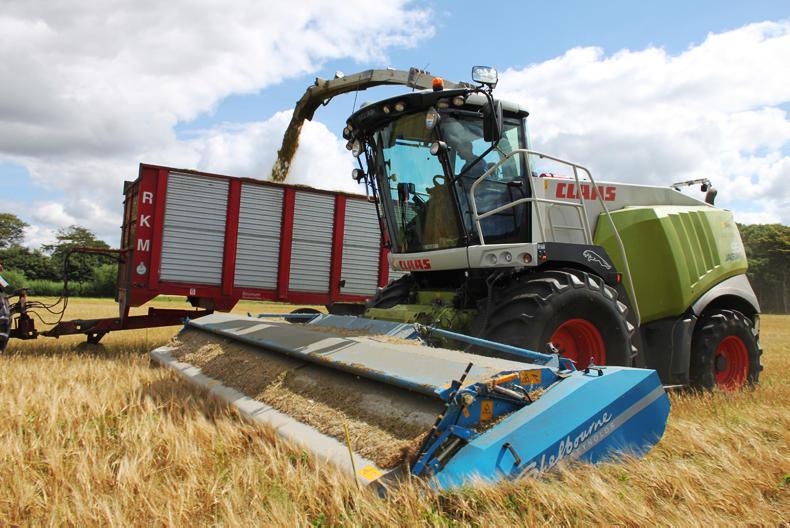Contractors seeking to extend the season for their forage-harvesters, those involved in crimping grain for cattle feed and large dairy units running their own forager could all benefit from a new idea developed in Denmark. This is the experience of a number of the country’s farming businesses.
Crimped grain’s value as a highly palatable home-grown feed suitable for use as a concentrate replacer is well proven, with further benefits including the fact that harvest doesn’t require the crop to be fully ripe, and it’s not necessary to dry or roll the grain.
But putting unripe, green material through a combine is rarely an easy process, while the need to pass the grain through a separate crimping process before storage creates a complex harvest system.
But a new technique increasingly being adopted by Danish contractors and dairy farmers could change that. By using a stripper header in conjunction with a cracker-equipped forage harvester, harvesting and processing is combined into a single process.
The straw then needs to be cut in a separate pass, but this gives it time to dry and ripen before being mown and baled, suggest users of the technique.
Following its development by the UK’s National Institute of Agricultural Engineering, the stripper header has been commercially produced since 1990 by Shelbourne Reynolds a firm based in Suffolk, eastern England. But its main market is in countries where cereal straw is short and no-till systems are commonplace, rather than the UK or Ireland with their heavier straw.
However, it makes an ideal tool for removing the heads from spring barley at the almost-ripe stage suited to crimping, according to Danish contractor Klaus Kirkeby. His experience suggests that a maize cracker-equipped forage harvester paired with a stripper header can do the job of harvesting and crimping grain in a single pass.
Ten of his dairy farmer customers last year employed him to harvest crimped grain in this way. All are organic milk producers, and as such face additional challenges in often needing to under-sow cereal crops in order to cost-effectively incorporate clover-grass mixes into their rotations.
“Harvesting a cereal crop where the grain and straw aren’t fit is already hard on a combine, but adding in a lot of green material from under-sowing makes it twice as tough,” he points out.
“By using a stripper-header-equipped forage harvester, we’ve overcome these issues. We have to make a separate mowing pass for the straw, but it can be left to ripen afterwards, which it does much faster as the top of the stem is opened up. Most of what we are being asked to harvest is barley, with a small area of oats.”
Already an established contractor, offering services including forage harvesting with a 653hp Claas Jaguar 960, Kirkeby invested in a 7.3m (24ft) stripper header in time for the 2016 harvest. Aside from an adaptation to fit the header to the forager rather than a combine, the unit is unaltered.
The rearward-rotating rotor inside the hood features eight rows of keyhole-shaped teeth which strip cereal heads, transferring them to an intake auger running at a fixed 200rpm, bringing them to the centre and conveying them to the forager’s feeder house where they pass on through the chopping cylinder and maize cracker before being ejected from the chute.
“At around 12.5km/h forward speed, we run the stripper rotor at 700rpm, around 200rpm higher than would be used for dry grain going through a combine. The cracker rollers are closed up as tightly as possible to ensure grain crackage, as unripe cereal grains are obviously smaller and softer than maize kernels. We’re getting pretty good results from this, although we are talking with Claas about rollers specifically for grain.”
In spring barley under-sown with grass/clover and cut around three weeks ahead of normal harvest date, the product from the forager is a grain/green matter mixture of around 65% dry matter. On organic farms, no additive is applied, although Kirkeby says there is no reason why one couldn’t be used in a conventional situation.
Most customers are ensiling the material in small, walled clamps which are firmly rolled, have grass layered on top and are double sheeted. An AgBag sausage-type system can also be used.
Kristian Clausen, who farms near Varde, western Denmark, with his son Kaspar, trialled the stripped/crimped under-sown barley technique during harvest 2016, courtesy of Bounum, another contractor offering the service. The Clausens have been producing organic milk since 1997, and run a herd of 540 Finn and Montbeliarde cows.
“Our short summers make ripening and harvesting difficult, so I wanted to replace the rolled barley element of our grass/maize silage-based TMR,” Kristian explains.
“But with this technique we’re also getting more feed value from the crop than we would from combining – there are no combine losses, less risk of heads and grains shedding and we retain some grass and straw with the barley. In addition, we aren’t waiting for the crop to dry, or spending money on grain drying.”
As this is his first year using the technique, and the product includes green material from the under-sowing as well as crimped barley, during FC&LSF’s early summer visit Kristian was unsure of likely analysis, but while the barley alone would be expected to have figures of around 60% DM, 13% CP and 13 MJ ME/kg DM, the mix of grass with the grain will alter this slightly.
“But after leaving the straw/grass/clover for a few days to dry and recover from wheelings, we also have something that’s sufficiently dry to mow and big bale before storing under cover as a further forage, plus which we have the grass regrowth ready for next year.”






 This is a subscriber-only article
This is a subscriber-only article






SHARING OPTIONS: